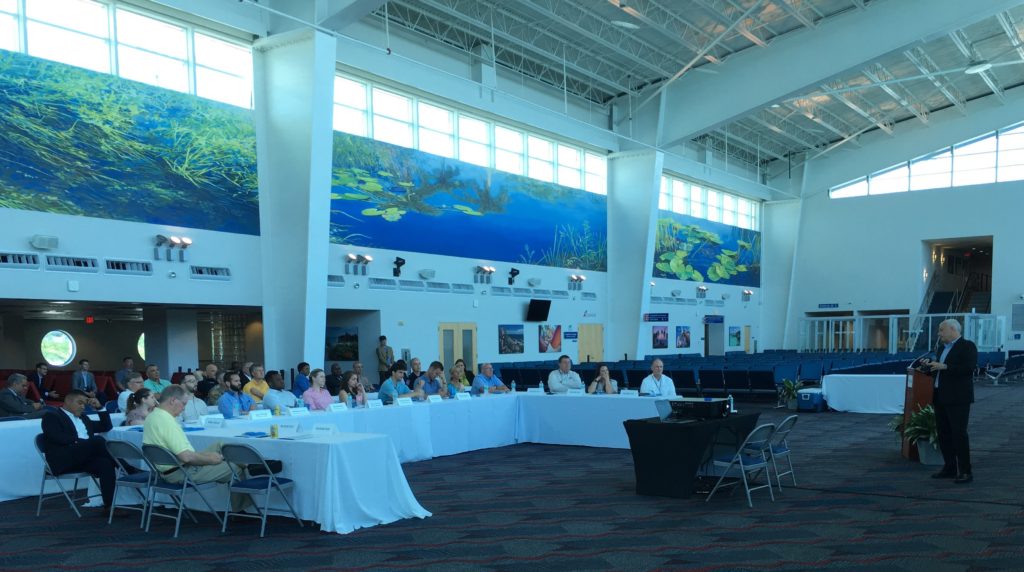News & Updates
Port tours for Congressional staff members continue today at PortMiami

TALLAHASSEE, Fla. (May 30, 2019) – Congressional staffers from the offices of Florida’s representatives in the House and Senate* gathered at PortMiami today to continue their tour of port facilities that began at Port Everglades on Wednesday. The Florida Ports Council (FPC) coordinated these educational tours and activities to allow federal representatives a first-hand look at the positive impacts made by strategic infrastructure investments at Florida’s seaports.
“These port tours are an initiative by the Ports Council to keep our representatives in the House and Senate informed, particularly on federal issues including security and investment,” said Doug Wheeler, president and CEO of the Florida Ports Council. “And our members at PortMiami and Port Everglades have tremendous success stories to tell, thanks to steady growth in global trade combined with successfully deployed capital infrastructure improvements.”
FPC partnered with Virgin Trains USA, formerly known as Brightline, to transport the delegation from Ft. Lauderdale to Miami. The privately owned and operated intercity passenger rail system reinvigorated a century old railway to connect the cities of Miami, Fort Lauderdale and West Palm Beach in 2017. Phase 2 expansion to Orlando recently began and includes the development of 170 miles of new track into the completed state-of-the-art intermodal facility located in the new South Terminal at the Orlando International Airport (MCO). Construction is expected to be complete and service will begin between South Florida and Orlando in 2022.
Today at PortMiami, the delegation was welcomed by PortMiami Director and CEO Juan M. Kuryla. In his capacity as the current Chairman of the Florida Ports Council, Mr. Kuryla highlighted the importance and the contributions being made by all Florida ports to the state economy and the wellbeing of its citizens. He especially emphasized the collaboration that exists between all Florida ports and federal agencies, specifically U.S. Customs and Border Protection and the U.S. Coast Guard. The delegation also toured cruise terminal operations including an overview of facial recognition processing technology, led by port officials and U.S. Customs and Border Protection personnel. Other activities included a tour of the recycling systems on the cruise ship Carnival Sensation, a view of PortMiami’s facilities at Cruise Terminal E and informal discussions with the state seaport security committee.
The delegation got a close look at PortMiami’s expansion of cruise terminals. Royal Caribbean opened its new Terminal A in November 2018, now homeporting some of its 5,400-passenger Oasis-class ships at PortMiami. The delegation also viewed the continued construction of Cruise Terminal B, The Pearl of Miami. The terminal is slated to open in early 2020. Once completed, it is anticipated to facilitate at least 1.3 to 1.8 million Norwegian Cruise Line passenger moves a year, generating $28 million or more in annual revenues for Miami-Dade County. Norwegian, which in late 2018 welcomed the 4,002-passenger Norwegian Bliss to its PortMiami lineup, has designed the new facility to accommodate ships in the 5,000-plus-passenger range.
Other projects in the works include MSC Cruises seeking to build a mega cruise facility for homeporting its largest class of vessels and once finalized, PortMiami will have inked the first $1 billion deal in the cruise industry. Disney Cruise Line has proposed a dedicated terminal as part of a pledge to increase its presence, while Virgin Voyages looks to break ground in fall 2019 on a 100,000-square-foot terminal slated for completion in time for the fall 2021. This terminal will service the line’s first ship, the 2,770-passenger, adults-only Scarlet Lady.
“PortMiami positively impacts local, regional, national and international business communities,” said Port Director and CEO Juan M. Kuryla. “From deepening our main channel to building new facilities, we achieve success with our projects when you deliver the message that our Port makes a difference in the economic development of our nation. Your voice makes a difference in significant port issues and Port funding requests. We ask for your continued support!”
The Port’s cargo partners are also making significant infrastructure investments. Seaboard Marine recently opened a new 15,000 square ft. maintenance and repair building offering enhancements to increase cargo handling capabilities as well as the maintenance of its equipment fleet. South Florida Container Terminal also launched a new cargo yard densification project to increase its operational capacity and container throughput. Port of Miami Terminal Operating Company keeps improving by investing in new container handling equipment and technological capabilities.
Florida seaports continue to work with local, state, and federal partners to ensure multimodal investments are in place to effectively and cost efficiently move containerized goods on-port, and to their final destination. Strategic planning and investments remain key elements ensuring Florida is prepared to service larger, new-Panamax vessels as a global hub for trade with the Americas, Europe, Asia and beyond.
*Attendees included staff from the offices of Senator Marco Rubio, and the following members of Congress: Val Demings, Mario Diaz-Balart, Neal Dunn, Lois Frankel, Debbie Mucarsel-Powell, Debbie Wasserman Schultz and Frederica Wilson.
###
About the Florida Ports Council
The Florida Ports Council is the professional association of Florida’s public seaports, providing advocacy, leadership and research on seaport-related issues before state and federal government. Florida’s ports support nearly 900,000 jobs in the state and contribute $117.6 billion to the state’s economy each year. The Florida Ports Council administers the Florida Seaport Transportation and Economic Development Council, which is required to provide a 5-year Florida Seaport Mission Plan annually according to Florida Statute. For more information, visit flaports.org.
